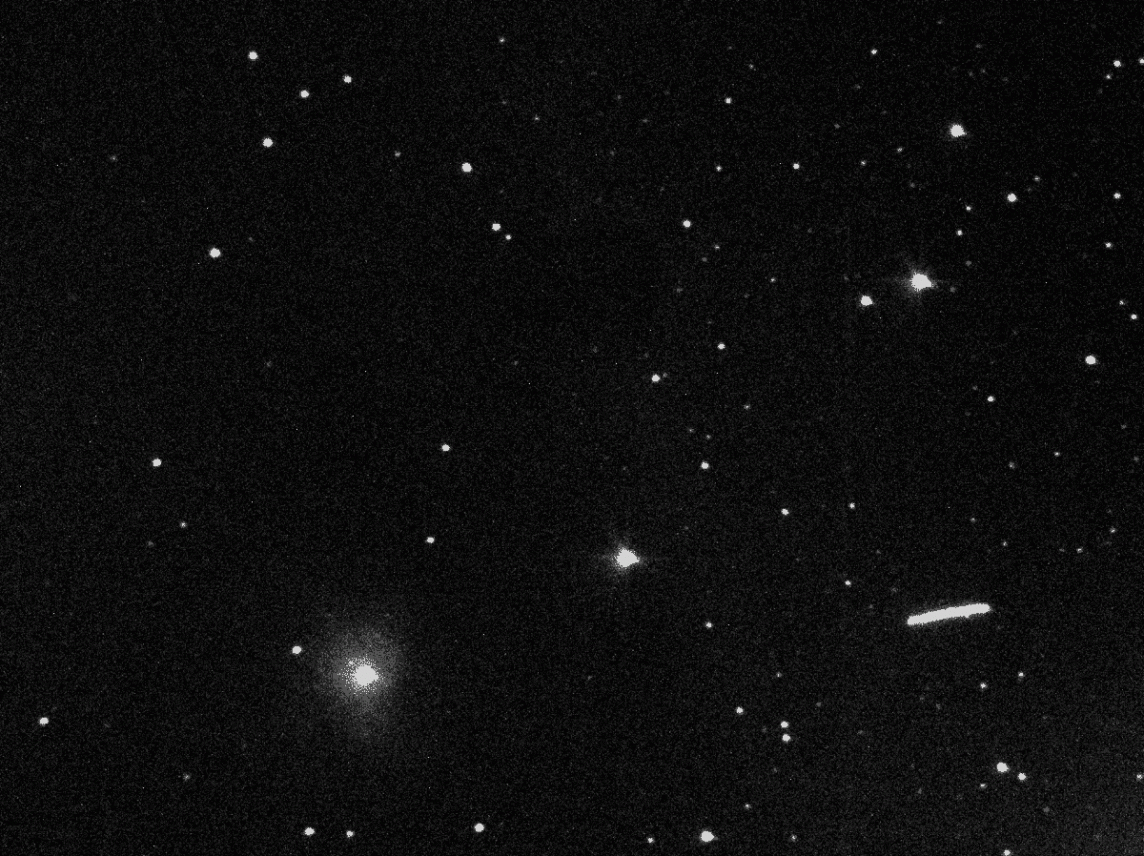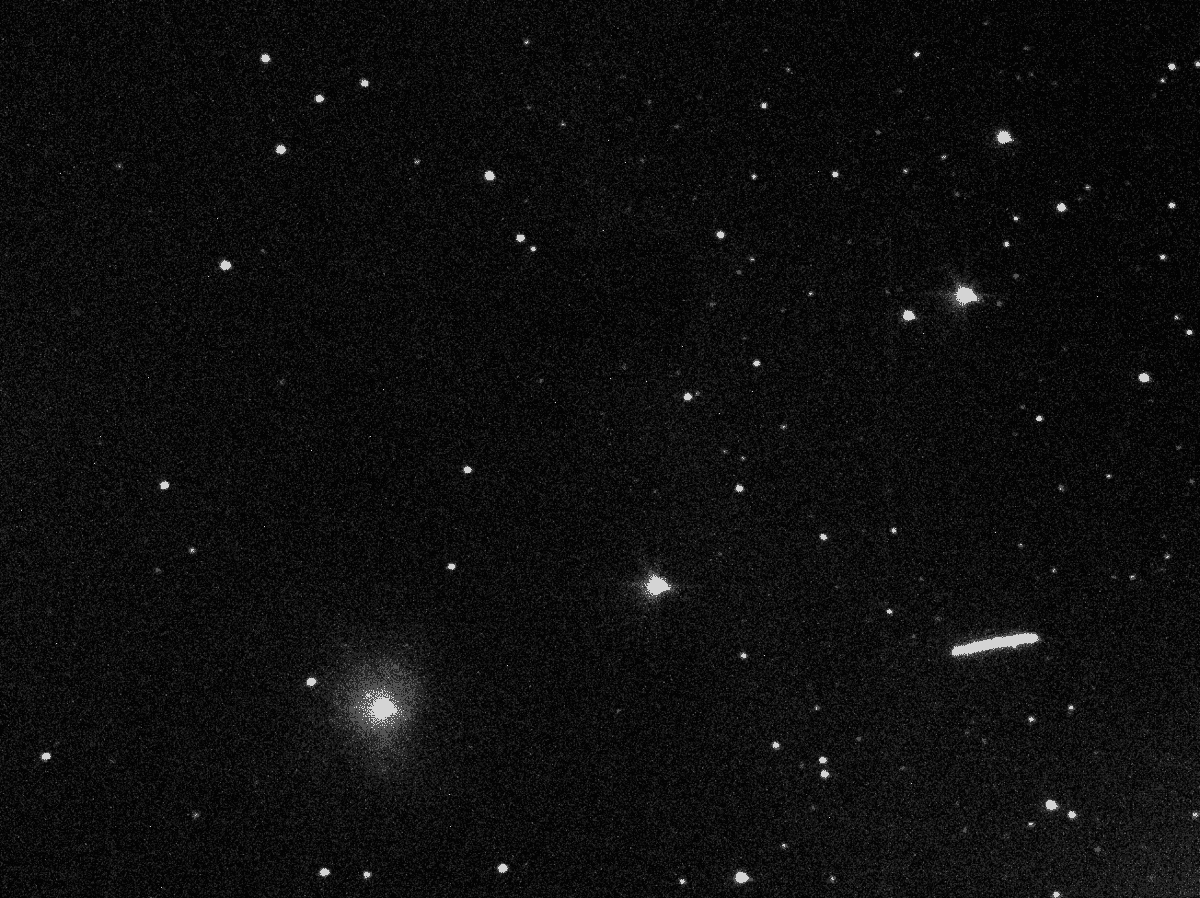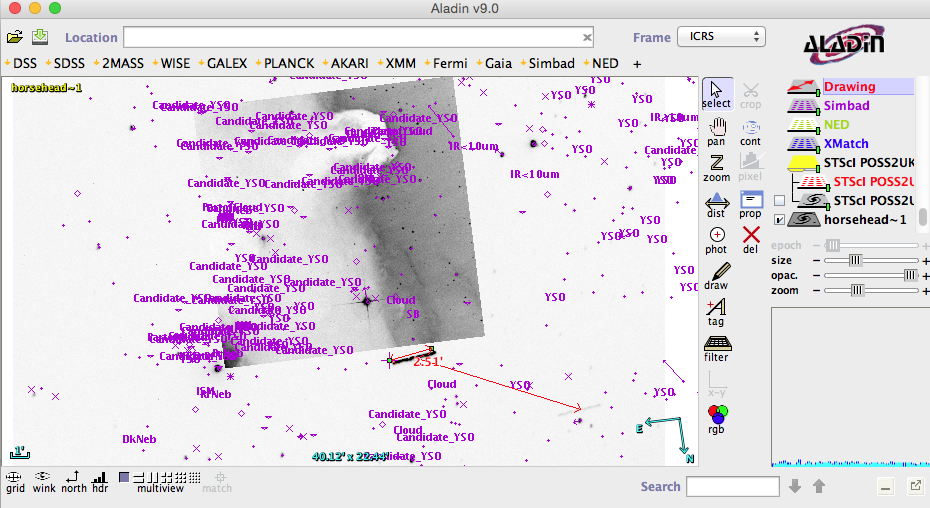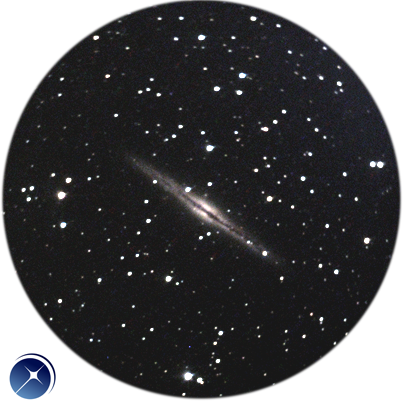There is a mystery in our galaxy, and astronomers around the world are working to solve it. The NASA Kepler mission revealed that planetary systems are […]
Unistellar is hiring – Communication and Community Management Internship
Something unusual for my blog, but why not… Unistellar is hiring a Communication and Community Manager in Marseille, France. If you like astronomy, want to work […]
Welcome Insight lander, you are on Mars!
Congratulations to NASA, JPL, Lockheed Martin and international partners for landing the Insight Lander on Mars a few hours ago. Like millions of people, I watched the […]
The End of Kepler – It’s not over yet but it will happen soon.
The Kepler space telescope, which was launched in March 2009, is the tenth NASA Discovery mission and the first dedicated to searching for and studying exoplanets. […]
Capturing a Snapshot of Pluto’s Atmosphere. The Story of an Occultation
Last Tuesday night, a large number of amateur and professional astronomers located across Mexico, the US, and Canada took advantage of a rare and exciting opportunity: […]
An Update on the Potential Habitability of TRAPPIST-1. No Aliens yet, but We’ve Learned a lot.
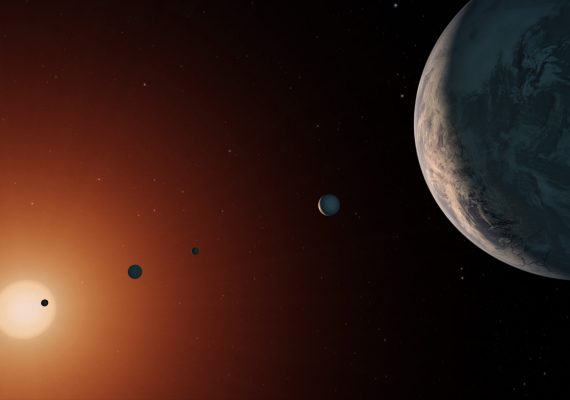
One year ago, I wrote an article about the remarkable discovery of the TRAPPIST-1 planetary system, a system of seven temperate terrestrial planets orbiting an ultra-cool red dwarf star. This was an enormous astronomical discovery because these low-mass stars are the most numerous ones in our galaxy, and the discovery of potentially habitable planets around one of them led many people to speculate about the existence of life there and elsewhere in our galaxy around similar stars.
This announcement also inspired a lot of additional studies by astronomers worldwide, who have used additional instruments and run complex models to better understand this planetary system and its potential for hosting life.
One year later, it seems to me that the time is right to give you an update on what we’ve learned about this planetary system, which is located only 41 light-years from Earth.
Better Understanding of the Planetary System
Between December 2016 and March 2017, additional data on TRAPPIST-1 were collected using the Kepler spacecraft in the K2 program. Kepler was designed to measure transits of exoplanets, but observations of TRAPPIST-1 were a huge challenge even for this remarkable planet-hunting spacecraft because TRAPPIST-1 is very faint in visible light. During its lifetime, astronomers have learned a lot about Kepler’s many capabilities, including better ways to reach the sensitivity necessary to detect the signatures of TRAPPIST-1-type transits (typically 0.1% the flux of the star). The authors of an article published in May 2017 in Nature were able to constrain the orbital period of the outermost planet, TRAPPIST-1h (P=18.766 days). Their work shows that the seven planets are, as suspected, in three-body resonances in a complex chain that suggests good stability over a very long period of time.
Keep in mind that we do not see the planets but detect only their shadow using the transit technique that gives us a good estimate of a planet’s size and its orbit. However, to truly understand the nature of a planet, we also need to determine its density, and hence its mass. In an effort to estimate mass in multiple systems, astronomers have used a technique called transit-timing variations (or TTV). This technique consists of measuring a small shift in the timing of a transit caused by gravitational interaction with the other planets in the system. Using a new algorithm and a complete set of data, including data from both TRAPPIST and K2, a team of scientists has significantly improved the density measurements of the TRAPPIST-1 planets, which range from 0.6 to 1.0 times the density of Earth, or a density measurement similar to what we see in the terrestrial planets in our solar system. If we also consider the amount of light we receive from these planets, TRAPPIST-1 e is probably the most Earth-like one in the system. A paper published in February 2018 also included a discussion of the interior of these planets and suggested that TRAPPIST-1 c and e have large rocky interiors and -b, -d, -f, -g should have thick atmospheres, oceans, or icy crusts.
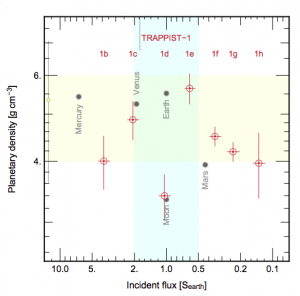
To understand a planetary system, we need accurate information about its most massive object, its star. Stellar astronomers have improved their knowledge of TRAPPIST-1’s star and now estimate its age to be between 5 and 10 billion years, which makes it older than our sun. This estimate is based on various methods, including the study of its activity, its rotation rate, and its location in the Milky Way. Its mass has also been revised to 9% the mass of our sun, which slightly affects the distance of the planet from the host star.
While observing the TRAPPIST system, astronomers have also detected strong star- like flares (seen, for instance, toward the end of the K2 observations). UV monitoring by the Hubble Space Telescope and by XMM/Newton combined with modeling revealed that the inner planets may have lost a large amount of water, but the outermost ones probably retain most of theirs. The complexity of these outgassing models and interactions with the stellar wind, when combined with planetary masses, are key to understand the nature of TRAPPIST-1’s planets and their potential habitability.
Dynamicists, who represent another important astronomical subdiscipline, have also taken an interest in this complex system. With seven planets surrounding a low-mass star, one can legitimately wonder about system stability. Their models show us that the system can be stable over billions of years, which is outstanding news if you want life to flourish there.
New Experiments and Innovative Ideas
We now have unambiguous proof of the existence of the TRAPPIST-1 planets, and we know about their orbits, their size, and their mass, but a lot still remains to be learned before we can claim that they have liquid water on their surface, and we need to know far more than that before we can conclude that these planets might be habitable, or inhabited.
One of the key challenges to computing the surface temperature of a planet is the existence and composition of its atmosphere. The atmosphere can act like a blanket, warming up the planetary surface. Using the Hubble Space Telescope, astronomers have attempted to detect the presence of rich hydrogen-dominated atmospheres around TRAPPIST-1 planets d, e, f, and g. Multi-color transit events taken in the near-infrared have ruled out such an atmosphere for planets d, e, and f. A H2-dominated atmosphere would lead to high surface temperatures and pressures, which are incompatible with the presence of liquid water. This negative detection suggests that these planets could have an Earth-like atmosphere with a temperate surface climate, which is more good news if, like me, you’re interested in habitability.

If life appeared on one TRAPPIST-1 planet at a time when it was hospitable, what are the chances that it spread throughout the entire system? Two astronomers discussed this hypothesis in a short article published in June 2017 and used a simple model for lithopanspermia (the transfer of organisms in rocks from one planet to another either through interplanetary) to discover that the likelihood of that happening is orders of magnitude higher than for the Earth-to-Mars system. In compact TRAPPIST-1, the probability of impact is higher and the transit time between planets is shorter, which makes contamination among planets more likely. They concluded that the probably of abiogenesis (the appearance of life) is enhanced for TRAPPIST-1. Of course, this is pure speculation based on physical considerations that need to be backed up by observations, but it reinforced the importance of finding such compact mini-planetary systems elsewhere the galaxy.
Life can exist on moons as well as planets, and a moon can be a significant contributor to the presence of life because its sheer presence can stabilize the planet’s axis of rotation and create tidal pools that may be necessary for complex molecules to form and interact. No moons have been detected around the TRAPPIST-1 planets, even though the Spitzer observations were able to detect a moon as large as Earth’s. Theoretical study shows that the inner planets (-b to -e) are unlikely to have small moons because of the proximity of their star and other planets. We are not yet able to detect the presence of a small moon circling one of the outermost planets, and will not be able to detect one without using bigger telescopes in space and on the ground.
Induction heating is a process used on Earth to melt metal. It occurs when we change the magnetic field in a conducting medium, which then dissipates the energy through heat. Astronomers have known for a few years that M-type stars like TRAPPIST-1 have a strong magnetic field. A group of astronomers studied the effect of such a strong magnetic field on the interior of planets in a system tilted with respect to the magnetic field of their star. Assuming a planetary interior and composition similar to Earth, they determined that the three innermost planets (-b, -c, -d) should experience enhanced volcanic activity and outgassing, and in some extreme cases have developed a magma ocean with plate tectonics and large-scale earthquakes, comparable to Io, a satellite of Jupiter. Again, this result is extremely model-dependent since we don’t yet have a clear idea of the internal composition of those planets, which will directly affect the strength of the induction heating. However, if they are truly Earth-like in composition, they could be a hellish version of our own planet.
Other scientists have also discussed the existence of significant plate tectonics and intense earthquakes in this system due to tidal stress introduced by planet-to-star and planet-to-planet interactions. If the activity is right, some of the TRAPPIST-1 planets could indeed be similar to Earth with the equivalent of continental plates, ocean floors, and active volcanoes, but one day we will need to take a picture to confirm this.
What’s next?
I have summarized some of the latest articles published over the past two years about the wonderful TRAPPIST-1 system. This list is not exhaustive and I probably missed some interesting ideas and new hypotheses about this complex system.
But one thing is crystal-clear: My readings have left me (and a lot of other people) stoked about what we might find from additional observations with large ground-based telescopes, including an Extremely Large Telescope (like the TMT, ELT, or GMT), or the James Webb Space Telescope (JWST). Each of these facilities is needed to constrain our models and refine our understanding of this system. For instance, long-term monitoring of the system with these facilities will place further constraints on the presence of moons in the system. Using the accurate photometry made possible by JWST, astronomers hope to constrain planetary masses and orbits to a great accuracy, derive the composition of their atmospheres, construct crude temperature maps of all of the planets in the TRAPPIST-1 system.
After 2020, if everything goes well with JWST and if the space telescope provides the superb data that we expect, we might have a crude map of the TRAPPIST-1 planets, similar to the rough image of Pluto made with Hubble Space Telescope and later validated by the New Horizons Spacecraft.

In less than two decades, nearby planetary systems like TRAPPIST-1 will become our cosmic backyard, and if everything goes as planned with missions like TESS, PLATO, ARIEL, and JWST as well as the ELTs, we will soon learn the secrets of those exotic worlds which, I am convinced, will surprise us by their diversity, just as our own solar system has surprised us over the past two decades, surprises us today, and will surely continue to surprise us in the future.
Clear skies,
Franck M.
If you want to learn more about the TRAPPIST-1 system, check out some of those articles (all available for free on ArXiV).
Boss, Alan P., Alycia J. Weinberger, Sandra A. Keiser, Tri L. Astraatmadja, Guillem Anglada-Escude, and Ian B. Thompson. 2017. Astrometric Constraints on the Masses of Long-Period Gas Giant Planets in the TRAPPIST-1 Planetary System. The Astronomical Journal, Volume 154, Issue 3, article id. 103, 6 pp. (2017). 154. doi:10.3847/1538-3881/aa84b5.
Bourrier, V., J. de Wit, E. Bolmont, V. Stamenkovic, P. J. Wheatley, A. J. Burgasser, L. Delrez, et al. 2017. Temporal evolution of the high-energy irradiation and water content of TRAPPIST-1 exoplanets. The Astronomical Journal, Volume 154, Issue 3, article id. 121, 17 pp. (2017). 154. doi:10.3847/1538-3881/aa859c.
Burgasser, Adam J., and Eric E. Mamajek. 2017. On the Age of the TRAPPIST-1 System. The Astrophysical Journal, Volume 845, Issue 2, article id. 110, 10 pp. (2017). 845. doi:10.3847/1538-4357/aa7fea.
de Wit, J., H. R. Wakeford, N. Lewis, L. Delrez, M. Gillon, F. Selsis, J. Leconte, et al. 2018. Atmospheric reconnaissance of the habitable-zone Earth-sized planets orbiting TRAPPIST-1. Nature Astronomy, Volume 2, p. 214-219 2: 214–219. doi:10.1038/s41550-017-0374-z.
Grimm, S, B-O Demory, M Gillon, C Dorn, E Agol, A Burdanov, L Delrez, et al. 2018. The nature of the TRAPPIST-1 exoplanets. Astronomy & Astrophysics. doi:10.1051/0004-6361/201732233.
Kane, Stephen R., and Stephen R. 2017. Worlds Without Moons: Exomoon Constraints for Compact Planetary Systems. The Astrophysical Journal Letters, Volume 839, Issue 2, article id. L19, 4 pp. (2017). 839. doi:10.3847/2041-8213/aa6bf2.
Kislyakova, K. G., L. Noack, C. P. Johnstone, V. V. Zaitsev, L. Fossati, H. Lammer, M. L. Khodachenko, P. Odert, and M. Guedel. 2017. Magma oceans and enhanced volcanism on TRAPPIST-1 planets due to induction heating. Nature Astronomy, Vol. 1, p. 878-885 (2017) 1: 878–885. doi:10.1038/s41550-017-0284-0.
Lingam, Manasvi, and Abraham Loeb. 2017. Enhanced interplanetary panspermia in the TRAPPIST-1 system. Proceedings of the National Academy of Sciences, vol. 114, issue 26, pp.6689-6693 114: 6689–6693. doi:10.1073/pnas.1703517114.
Luger, Rodrigo, Marko Sestovic, Ethan Kruse, Simon L. Grimm, Brice-Olivier Demory, Eric Agol, Emeline Bolmont, et al. 2017. A seven-planet resonant chain in TRAPPIST-1. Nature Astronomy, Volume 1, id. 0129 (2017). 1. doi:10.1038/s41550-017-0129.
Tamayo, Daniel, Hanno Rein, Cristobal Petrovich, and Norman Murray. 2017. Convergent Migration Renders TRAPPIST-1 Long-lived. The Astrophysical Journal Letters, Volume 840, Issue 2, article id. L19, 6 pp. (2017). 840. doi:10.3847/2041-8213/aa70ea.
Van Grootel, Valerie, Catarina S. Fernandes, Michaël Gillon, Emmanuel Jehin, Jean Manfroid, Richard Scuflaire, Adam J. Burgasser, et al. 2017. Stellar parameters for TRAPPIST-1. The Astrophysical Journal, Volume 853, Issue 1, article id. 30, 7 pp. (2018). 853. doi:10.3847/1538-4357/aaa023.
Zanazzi, J. J., and Amaury Triaud. 2017. Initiation of Plate Tectonics on Exoplanets with Significant Tidal Stress. eprint arXiv:1711.09898.
AI as a Tool for Planetary Defense: How a Computer Could Help Us Make the Right Decisions When Facing An Asteroid Threat
Last May, a diverse group of astronomers, space agency executives, government representatives, and theorists who study tsunamis and asteroid impacts met for a week in Tokyo to discuss the state of planetary defense. This group also included a few members of the NASA’s Frontier Development Lab (FDL), an applied research accelerator, aims to foster collaboration between AI experts and planetary researchers expressly for the purpose of finding solutions to NASA global challenges, including Planetary Defense.

The conference took place at Japan’s Miraikan (literally, “Future Museum”), which seemed highly appropriate given that our topic was the threat posed by asteroids and comets, and the actions we might take to address it. After listening to talks by several experts, attendees began a role-playing game which simulated the threat of a ~200m asteroid that might—or might not—strike Earth in ten years. Over the course of a week, we took on the role of government officials, United Nation committees, scientists, and journalists, making decisions on how to handle the threat, communicate it to the public, and solve it, using every bit of information we have about asteroid detection and mitigation.
The short version of what happened is this: we decided to send a complex armada of spacecraft to the asteroid to inspect it, and then detonate a nuclear device to deflect it away from Earth. The week ended well, since the asteroid missed our planet, thanks to our skilled application of science and technology. We all felt like shouting a relieved hooray, but in reality the outcome was not that simple. True, this was only a simulation or game—but it taught us much about the enormous and sometimes overwhelming difficulties humans face when we have to take unbiased, logical decisions in times of acute crisis..
In our exercise, the asteroid was discovered on Day 0 (simulation date May 15, 2017) but until Day 2 (November 30, 2018) we had no clear idea where impact was supposed to occur. All we knew was that several countries were on the risk corridor—including Japan, China, Russia, Denmark and Ireland—that the impact had a one percent chance of occurring, so a Level 4 on the Torino scale, which measures hazards associated with near-Earth objects.
Tensions increased on Day 2, when we learned that the probably of impact was 96% along a corridor somewhere between Beijing and Tokyo—a terrifying prospect because this is one of the most densely populated and economically developed parts of world. At that point it was clear that the “world” (i.e., all conference attendees) had to devote enormous resources to handle the threat.
The Day 2 of the simulation was probably the most challenging because it generated complex, difficult, and sometimes heated discussions between scientists and politicians. On one hand, space agencies had designed two rendezvous missions and several kinetic impactor spacecraft that could divert the asteroid away from Earth. But several government leaders were nervous about focusing solely on kinetic diversion and suggested installing a nuclear device on the rendezvous missions because it would give us a Plan B—the opportunity to explode the object. This dispute generated a discussion on an enormous number of questions about the asteroid and its size, density, and orbit, all of which needed answers if we were to assess the relative feasibility of these two mitigation scenarios. Government leaders were not satisfied with scientists’ answers, which seemed too tentative and cautious. Engineers from space agencies had a hard time explaining the pros and cons of various mitigation scenarios to government leaders and the risks of failure presented by each. Our day was full of controversy, and government leaders grew exasperated, losing patience as they faced an overwhelming need to act, and act now.
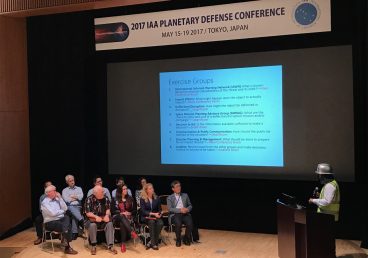
The Day 3 intensified rather than relieved our anxiety, because that’s when astronomers discovered that the asteroid was in fact a binary system with two components of 270 m and a 100 m, an enormous and unanticipated complication for the deflection campaign. And, to make matters worse, we were no longer sure if the kinematic impactor strategy would work because the large object was denser than expected and its companion was only loosely bound to it. The problem we faced was very complex: successful diversion of the primary might not deflect the secondary, which might then continue on a separate path and wipe out the city of Tokyo, which had by now been the confirmed as ground zero. Despite those dire facts, nations still could not agree to install a nuclear device on the reconnaissance spacecraft.
On Day 4 (June 15, 2023, one month before launch), we learned that the collapse of several governments and various changes of leadership now made it possible to install a nuclear device on the two rendezvous missions.
In the end, one of our rendezvous spaceships made it to the asteroid and one missed. On Day 5 (February 28, 2024), decision makers decided to deploy the nuclear device and detonate it 1 km from the two components. This appears to have been the right decision because the primary was slightly nudged away from Earth and the secondary was destroyed. An alternative scenario with four kinetic impactor strikes also succeeded but would have occurred later in 2024, and have been an all-or-nothing shot with no Plan B. Considering the state of global disarray, and the deepening political and economical crisis we faced, we no longer believed that politicians would have taken the risk of waiting until 2024 to act. The urge to do something now would have overwhelmed other considerations, and that would have doomed any approach that called for four kinetic impactor strikes.
What did we learn from the simulation? The clearest and most disturbing lesson was this: if a deadly asteroid were set to hit our planet, we would have a hard time making the right decisions. Because we’ve never diverted an asteroid, it might well be too risky to run such an experiment without prior tests. Considering the significant amount of funding such an experiment would take, we came away from this exercise with a strong belief that we need to prioritize a study of mitigation strategies and approaches, using all the data we have on threatening asteroids

Fortunately, in 2016, the NASA Frontier Development Lab (FDL) was charged with answering outstanding questions of planetary defense by bringing planetary astronomers together with AI experts to work for a limited time at the SETI Institute.
One of the Lab’s teams chose to develop what it calls a Deflector Selector, an AI algorithm that will assess the efficiency of several mitigation scenarios based on a realistic population of asteroids. Team members decided to focus on three technologies: nuclear devices, kinetic impactors, and gravity tractors, which have not yet been developed and tested in space.
After creating an artificial, but realistic, population of 6 million objects, this group simulated the detection of those asteroids and the time necessary for a mitigator spacecraft to reach them. Finally members simulated a deflection, taking into account the size, orbit, and density of the asteroids, the launch vehicle (and thus the mass of the payload), and the properties of the deflector technologies. If we know these factors, we can estimate the success/failure ratio for a population of asteroids.
This simulation produced a multidimensional data set that required up to forty hours of run time on one hundred core computers. In theory this simulation could be repeated with slightly different populations, but computing these calculations is expensive. Instead, the team decided to train an AI on the first population so it could predict in mere seconds which combination of technologies would work best on an asteroid based on factors such as its orbit and composition.

The Deflector Selector teaches us that nuclear devices are the most effective deflection method for 50% of the asteroid population, but we have be very careful here because a launch vehicle failure could have a significant impact on life on Earth. In some cases kinetic impactors are almost as effective as the nuclear option but that depends on the internal composition of an asteroid, which is still poorly constrained. Thankfully, space agencies have launched, or will soon launch, space missions like AIDA, OSIRIS-REX, and Hayabusa 2 to collect these measurements on a real asteroid sample or study the interior by kinetic impact. Gravity tractors require a long lead-time before impact, which is a function of the orbit and the size of the asteroid. We need better asteroid monitoring and detection surveys before we can effectively use this mitigation technology. LSST, NEOCAM and other all-sky surveys should be prioritized if we are serious about peacefully protecting our planet from those asteroid threats.
Clearly, then, AI has a key role to play in planetary defense, and we have begun using it in innovative and effective ways. But the problems we face are so complex that we will need one, and probable several, smart computers to assist us—and possibly to help us get fast and accurate answer in times of crisis—times when the fate of our fragile world hangs, literally, in the balance.
Clear skies,
Franck Marchis
An article describing the Deflector Selector algorithm has been accepted for publication in Acta Astronautica
The Deflector Selector: A Machine Learning Framework for Prioritizing Hazardous Object Deflection Technology Development, Erika R. Nesvold, Adam Greenberg, Nicolas Erasmus, Elmarie van Heerden, J. L. Galache, Eric Dahlstrom, Franck Marchis, in press, 2018

Intriguing pair of satellites caught with the eVscope
If you often look at the evening dark sky in a clear area far away from the city, you have probably seen a speck of light which moves with respect to the star, that’s probably a distant satellite that shines because it reflects the light of the sun at high altitude. According to NASA’s Orbital Debris Program office, there are an about 21,000 large debris (>10 cm) and satellites orbiting around Earth right now, so much more than you can see with your naked eye.
The eVscope is designed to pinpoint and image Deep Sky Objects (nebulae, galaxies), but we have already shown its potential to observe dwarf planet like Pluto, as well as asteroid like Florence. Because the telescope can image targets as faint as those astronomical bodies, we thought that it will also be able to image small satellites and debris as well passing serendipitously in the field of view. This is what happened a few days ago.
Our team observed from Pourrieres, 50 km from Marseille on November 15 2017. The goal was to test the eVscope on faint winter-sky objects, which including the iconic Horsehead Nebula. At 22:48 UT, the observer pointed toward the target and saw briefly during the acquisition in the eyepiece a small moving target crossing the field of view.
The SETI Institute team inspected the individual raw frames and tried to identify the target. We quickly realized that this bright target (V~10) was not an asteroid but probably an artificial satellite.
More interestingly when we looked at the data more carefully, we saw a second satellite, 8-10 times fainter, which was moving together with the bright one at 9.8 arcmin and 5’o clock. The motion for both satellites with respect to the star is 1 min per min, so that’s probably a geostationary pair of satellites, even though we noticed that they are both inclined by ~4 deg with respect to the equator.
Mysteriously, we could not identify yet the satellites despite a search in the NORAD database and other tools available on the web. That’s probably something that we will do in the future and I will post regular updates here. If you have an idea, please let us know!
The followup and the characterization of space satellites and debris in orbit around Earth is another possible use of the eVscope. We had mentioned this several times in the past and nature gave us the bit of luck that we needed to show it.
Clear Skies
Franck M.
1,500th telescope on our Kickstarter. Thank you!
We have just passed the pledge of our 1,500th telescope on our Kickstarter campaign. With such an amazing number of eVscopes soon to be in operation around the planet, our Campaign Mode and Citizen Science applications will be extraordinary exciting and revolutionary! Your support has brought us to this truly amazing moment, and all we can say is thank you.
After so many questions about planets and requests for additional photos, we felt the need to conduct new observations—and despite bad weather in parts of the Northern Hemisphere, we managed to do it! As you check out these pictures, please keep in mind that what you see through the eVscope’s eyepiece is far more beautiful and mind blowing. The image quality and observing experience there are definitely superior to what you see in these photos.
The eVscope provides truly amazing astronomical views when pointed at nebulae and galaxies. As you can imagine, the Unistellar team has seen lots of targets over the past three months, but we were delighted to see new ones with our eVscope because they are so beautiful and awe-inspiring.
Spiral Galaxy NGC891, for example, is an unforgettable sight in the eyepiece of an eVscope. It’s similar to our Milky Way, but because we see it edge-on, the structures made by the dust and gas are particularly striking.
Of course, we also observed one of the most iconic objects in the night sky, the Orion Nebula (M42). This object is a stellar nursery and contains a very young open cluster known as the Trapezium. Its coloration is caused by the excitation of gas that surrounds these young stars.
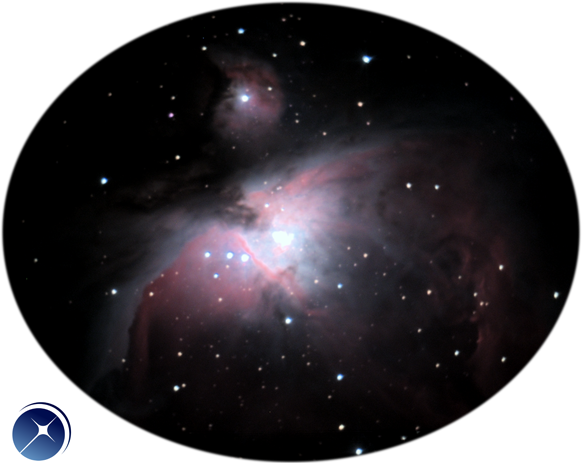
Picture of the Orion Nebula observed with the eVscope from Pourrière, South of France (magnification x 50).
Many of you asked about planets. Keep in mind that they are smaller and brighter than deep-sky objects. We designed the eVscope to view deep-sky objects that are faint and extended, and that’s why our device is not optimal for viewing planets. But as you can see in the following picture, Saturn and its rings are clearly visible in an eVscope, despite their current low elevation in the sky.

Saturn observed from Nairobi, Kenya with a numerical zoom x150 on October 29 2017. Image taken at 20 degrees elevation (poor atmospheric conditions)
We will continue to post pictures of targets on our blog and in our newsletter and our social media. Join us there!
Clear Skies
Unistellar Signs Up More Than 1,200 Early-adopters for its Revolutionary eVscope Confirming the Public Interest for Citizen Science Astronomy
Unistellar Signs Up More Than 1,200 Early-adopters for its Revolutionary eVscope Confirming the Public Interest for Citizen Science Astronomy
San Francisco & Marseille, November 9, 2017. Unistellar, a startup that’s committed to restore the joy of night-sky viewing to people all over the globe, is off to a strong start thanks to the massive success of its recent Kickstarter campaign.
The campaign gave supporters the opportunity to order an eVscope, a revolutionary, electronics-based telescope that offers unprecedented views of distant objects in the night sky. The device also allows users to make significant contributions to science by joining observing efforts led by prominent astronomers.
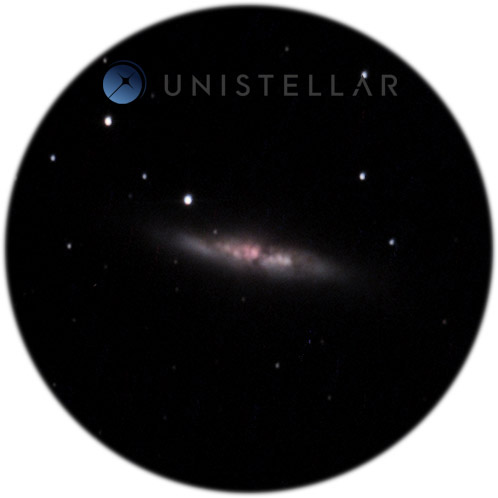 “After three years of prototype development, building, and testing, we were proud to bring our compact, intelligent, and powerful telescope to market,” said Arnaud Malvache, President and CTO of Unistellar, located in Marseille. “Our team also demonstrated the prototype at several star parties in Europe and the USA, and these efforts paid off beyond our wildest expectations, with a landslide of backers.”
“After three years of prototype development, building, and testing, we were proud to bring our compact, intelligent, and powerful telescope to market,” said Arnaud Malvache, President and CTO of Unistellar, located in Marseille. “Our team also demonstrated the prototype at several star parties in Europe and the USA, and these efforts paid off beyond our wildest expectations, with a landslide of backers.”
The campaign went live at 7 a.m. Pacific time on Oct. 25, when the company began taking orders for eVscopes at early-bird prices. In just a few minutes, the first 150 telescopes were gone—which put Unistellar at its fundraising goal, making this one of the most successful Kickstarter campaigns ever, and likely the biggest success for an amateur astronomy project on Kickstarter.
Backers continue to pour in. At last check, Unistellar had raised over $1.6 million with more than 1,200 eVscopes pledged.
Each eVscope includes light-accumulating Enhanced Vision Technology that gives the device the light-gathering power of telescopes ten times larger in diameter. For most viewers, this means unprecedented access to colorful nebulae, galaxies millions of light years away, and faraway planets—objects that are far too faint to view through backyard conventional telescopes. And thanks to built-in sensors, GPS, and an internal map of millions of stars, the eVscope can pinpoint and identify any object in the sky, making astronomy easy as well as informative.
The campaign’s success also marks a huge victory for citizen science. Thanks to Unistellar’s partnership with the SETI Institute, eVscope users can join astronomical viewing campaigns led by scientists. These campaigns are expected to produce unprecedented amounts of data generated by a global array of eVscopes. This information will be stored in a database at the SETI Institute, where it will be available to scientists all over the world.
“Our successful crowdfunding campaign confirms the desire of amateur astronomers and space fans to enjoy the night sky while they contribute to scientific investigations and generate new astronomical data. This is step one toward the creation of an active network of citizen-science astronomers who will monitor the sky 24/7 from almost everywhere on our planet,” said Franck Marchis, Chief Scientific Officer at Unistellar and Senior Astronomer at the SETI Institute.
The Unistellar team organized several demos in summer 2017 to showcase the eVscope’s capabilities. Starting in July, the Eastbay Astronomical Society (Oakland, CA) got the chance to incorporate the eVscope prototype and the developer team’s expertise into its public outreach events at the Chabot Space & Science Center. The innovative eVscope was seamlessly integrated into EAS activities, together with more traditional and much larger-aperture telescopes.
“The vivid color views in the eVscope were immediate crowd magnets and the Unistellar team had people lining up to enjoy the clusters and nebulae shown in the electronic eyepiece of this new device,” said Gert Gottschalk, board member of the EAS and amateur astronomer. “The Unistellar team and its telescope immediately became integral to outreach activity at EAS.”
“We’re overwhelmed by the success of our campaign and grateful for the many emails, including comments and ideas from our supporters,” added Laurent Marfisi, CEO of Unistellar. “These early adopters will help us make an even-better product, a uniquely powerful, easy-to-use device that gives them back the sense of awe and wonder that the night sky has engendered in humans since our species first appeared on this planet.”
The Kickstarter campaign runs until November 23 at midnight PT.
Link
Link to the Kickstarter campaign.
Images
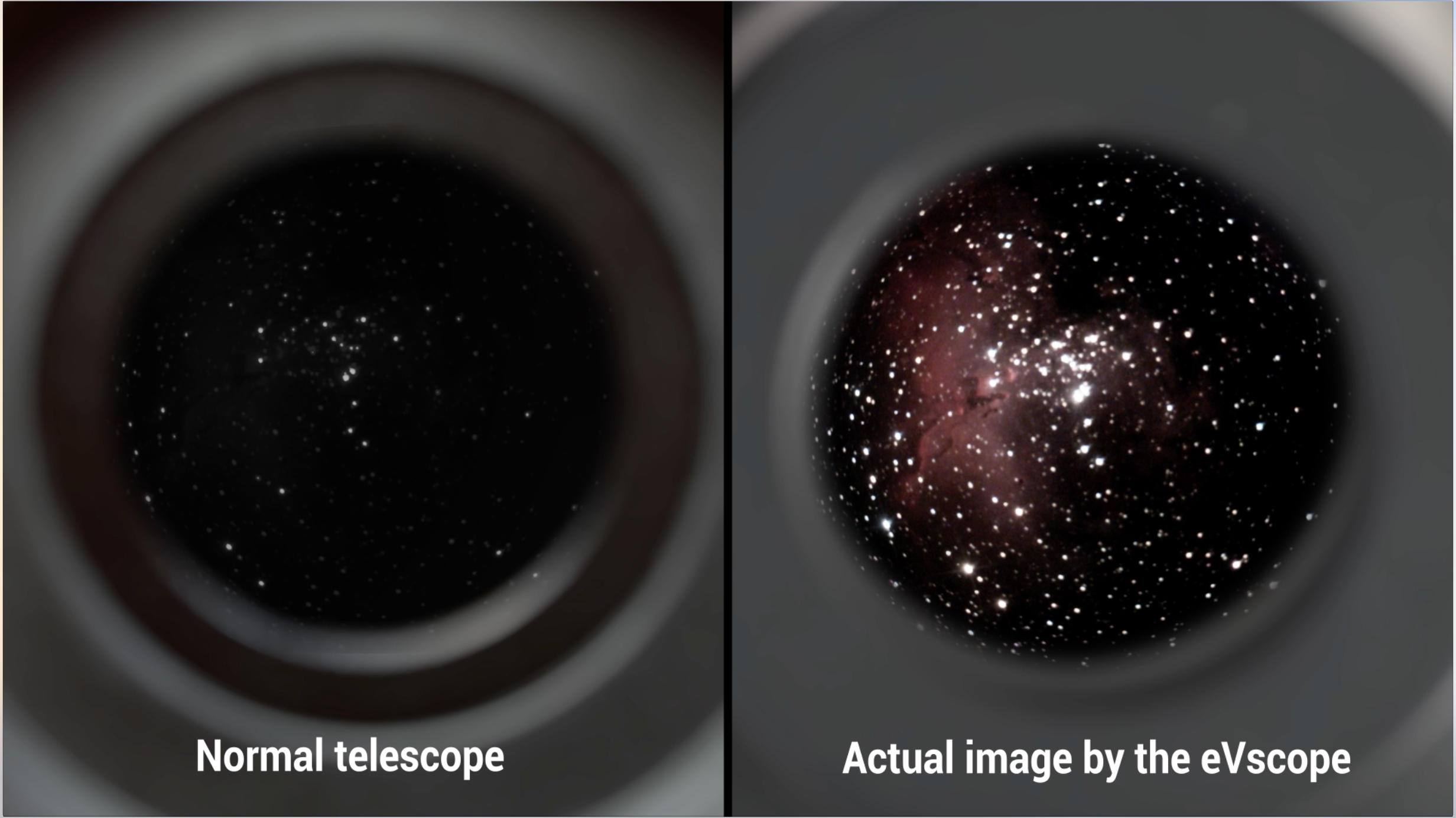
Comparison between an observation with a classical telescope and with the eVscope
Videos
Our Kickstarter video
Leo Tramiel, amateur astronomer & co-inventor of the Commodore PET, witnessed one of our demos.
Demo at Marseille Observatory.
Enhanced vision experience
https://www.youtube.com/watch?v=Qq_VLOn8ckc
Previous press releases
SETI Institute partnership press release:
http://cosmicdiary.org/fmarchis/2017/07/22/seti-institute-unistellar-partnership-promises-to-revolutionize-amateur-astronomy/
It’s Official! The eVscope from Unistellar Gets Kickstarted
http://cosmicdiary.org/fmarchis/2017/10/28/its-official-the-evscope-from-unistellar-gets-kickstarted/
About Unistellar:
Unistellar is reinventing popular astronomy through the development of the Enhanced Vision Telescope™: a smart combination of optics, electronics, and proprietary image-processing technology that aims to make astronomy interactive. Unistellar is completely dedicated to its popular ambition, but its technology has already garnered attention for other applications from established institutions for like the ONERA (the French aerospace agency) and companies focused on Imaging. http://unistellaroptics.com/http://unistellaroptics.com/
Media contact :
Laurent Marfisi
CEO
Email: laurent.marfisi@unistellaroptics.com
+33 6 77 98 01 20
Franck Marchis
Chief Scientific Officer
Email : franck.marchis@unistellaroptics.com
Senior Astronomer at the SETI Institute
Email : fmarchis@seti.org
+1 510 599 0604
